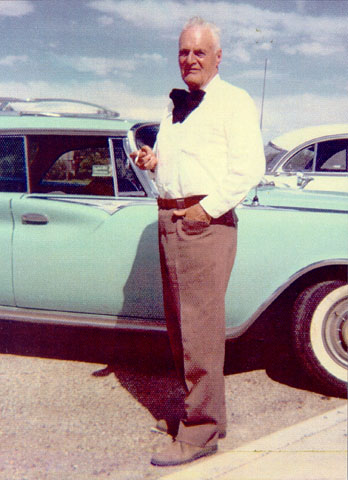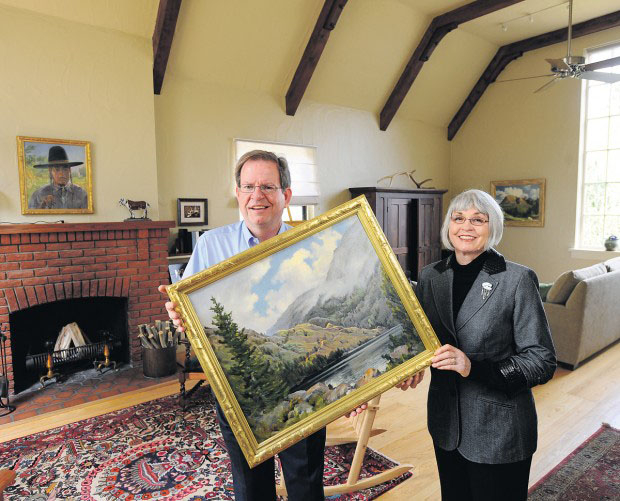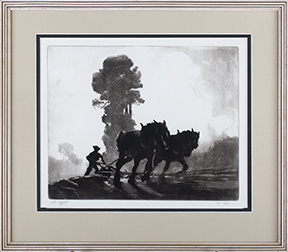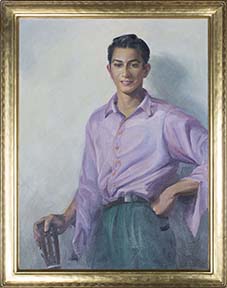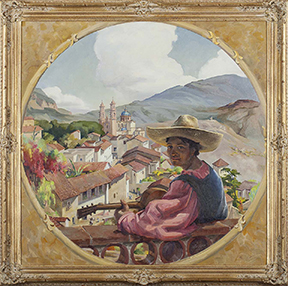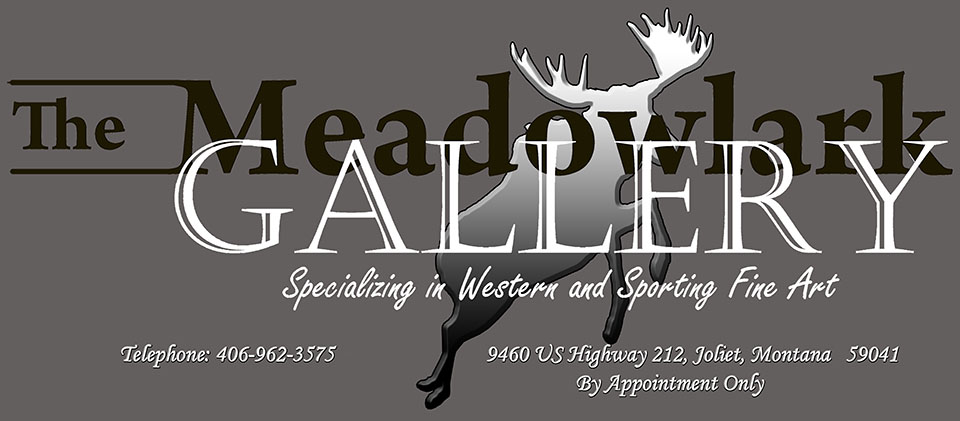 |
||
LeRoy Greene (1893-1974) |
||
LeRoy Greene was born in New Jersey. He began work as an errand boy for a jewelry store, and later received training as a jeweler. In 1916 Greene began working his way West, pausing to work for a time in the wheat fields of Minnesota. It was the mountains and the weather that convinced him to settle in Billings. There he owned and operated a jewelry store for many years, while continuing to paint. When he opened his own shop on Montana Avenue and 26th Street, he assembled his own tools and built most of his equipment. The work benches were designed to become crates to store the tools and were easily shipped to him when he took two years of art at the Otis Art Institute in Los Angeles. In school he concentrated on painting but made jewelry for a wholesaler to meet expenses. He trained with portrait artist Wayman Adams and acquired the skill to paint skin texture and eye depth. In 1929, he returned to Billings to set up shop on the fourth floor of the Stapleton Building, creating his sculptured jewelry in wax he mixed himself. He cast the intricate pieces and became "an artisan in the noble metals." He continued to paint. He soon moved into a larger room with studio windows, ideal for painting, on the third floor. Four months in Provincetown, Massachusetts, studying with George Elmer Browne developed his mastery of the landscape. Greene built an etching press in his studio, became proficient with the techniques and later sold the press to Montana State University in Bozeman. By 1930, students from all over the country were coming to take art classes from him in the studio he had opened. He was a master of etching, watercolor, sculpture, drawing, and oils. "Color should enhance the value of the drawing," said Mr. Greene. He believed a painter should be able to withstand some discomforts to paint the abundance of nature. In 1930, a friend came to his studio with a Crow Indian named Ties His Knees. It was the first of the Crow portraits Greene did, portraits now scattered over the United States. The Crow paintings were done from the 1930's into the 1960's. Mrs. Greene has always kept very accurate records on every painting produced since she knew him. The last recorded work was numbered 2505. She made a comment to me that it was hard to tell how many were produced prior to her relationship with him. "Toward the end he was having difficulty with his eyes and arthritis and emphasema. One day he wanted to go over and paint a barn we'd seen in our travels around. He and a friend drove over to paint the old barn that was in it's last stages. Roy died in the jeep on his way home. That was a good way of going. Doing what he wanted to do." Mrs. Greene named the unfinished painting, "Amen." It was the end of the barn and the end of a career. LeRoy Greene was 80. A close friend of LeRoy Greene was Emery Wetzel. Emery told us that LeRoy once told him this about his artwork. "I try to price my paintings so that the common man can own one if he wants to........" LeRoy Greene
Painter’s heritage comes homeby JACI WEBB of The Billings Gazette Staff It’s been almost four decades since the sturdy brown house designed by LeRoy Greene near Pioneer Park showcased the prolific Billings painter’s works. But come Saturday, the home, now owned by Lance Crosby and Jessica Amsden, will again be packed with Greene’s distinctive oil and watercolor paintings, 36 years after Greene’s death. Starting in the 1940s through the time of his death in 1974, Greene opened his home to buyers at weeklong shows, when he would offer as many as 200 paintings for sale. Sixteen paintings will be hung on both floors of the home Saturday during the Heritage Tour of Homes. Thirteen of those paintings are also for sale. “He’s one of those artists I can tell his work from the minute I see it, even if it’s from 10 yards away,” said Gary Temple, owner of Meadowlark Gallery. Temple is loaning 15 of the 16 paintings for the display Saturday. Over the fireplace, which is in the sunken living room designed by Greene as his painting studio, a portrait of a Crow Indian will hang. It’s not the same portrait of the 93-year-old Crow chief Plain Feather, which hung over the fireplace when the Greenes lived there, but it is from the series Greene completed starting in 1930 of Crow men and women. Rare for an artist of his time, Greene insisted on painting outside at various sites around the region. He also made numerous trips to the Crow and Northern Cheyenne reservations to find subjects to paint and often invited them to come to his Billings studio. Greene’s daughter Marilyn Warford said he would pay models $10 to sit for three hours at a stretch in his studio. An only child, Warford said she would tip-toe around the house or play at friend’s homes when her dad was painting. “When he was in the house painting, he was off-limits,” said Warford, who now lives in Corvallis, Ore. “I had to be really quiet. Periodically, he’d go sit in his big chair and contemplate his painting and then approach the canvas and make a few dabs of paint.” The late Billings artist Hall Diteman recalled Greene as a hard-working, quiet man who often painted two oil paintings in a day. During an interview for a 1970s documentary film on Greene’s life and work, Diteman called Greene a pioneer. “He was a real gutsy painter and he pioneered oil painting in this country,’’ Diteman said. “He just loved to paint. He worked with oils the way you work with watercolors, with a sense of immediacy.” Filmmaker Ron Bradford, who created the 1970s documentary on Greene, said Greene’s work was popular because he mastered the technique of capturing light. “He was known for his ability to catch the light in the eye to make it feel real and he was able to paint water,” Waterford said. Paintings will not be sold during the Heritage Tour, but interested buyers can contact the Meadowlark Gallery next week. Crosby and Amsden bought Greene’s painting “Sheep Shed” after finding out they had purchased his former home in 2007. The couple found remnants of Greene’s world, including a hat in the attic and old paint tubes and cigarette butts in the ash bin. They became so intrigued by Greene that when the couple traveled in Oregon to visit their son last year, they visited Warford to find out more about his life. Since then, Crosby has looked at dozens of Greene paintings held in private collections in Billings. He discovered an early painting of Red Lodge Mountain ski hill and a wall mural Greene painted in a neighborhood home. “His work was everywhere, including the jewelry he made,” Crosby said. Greene was born in New Jersey in 1893 and worked as an errand boy for a jewelry store, later training as a jeweler. In 1916 Greene worked his way west, eventually settling in Billings where he operated a jewelry store on Montana Avenue and North 26th Street. After studying art at the Otis Art Institute in Los Angeles, he returned to Billings in 1929 and opened a studio on the fourth floor of the Stapleton Building. He designed the family’s home when it was built in 1940, carving the first beam for the studio to show the builder how he wanted it done. When he didn’t have the proper tool for a project, Greene invented one. Warford said her father invented an engine he tried to sell to Ford Motor Co. and designed and built an etching press, which he later sold to Montana State University. Greene believed it was important to establish a relationship with the people who bought his paintings. That is part of the reason he sold most of his work out of his home at 2009 Virginia Lane. His late wife, Ella, named most of his paintings and kept a card file on every piece, including information about when and where it was painted. Warford, who inherited those records, said she got to name a few of the works herself when her mother ran out of ideas. Ella kept records on 2,500 paintings. Greene was as drawn to working men in his portraits, and to ramshackle barns ready to topple, as he was to the city’s elite, including P.B. Moss, and the region’s iconic peaks, like Pilot and Index in the Beartooth Mountains. A painting of a well-known Billings cellist, Julius Clavadetscher, still hangs in the Senior High auditorium. Warford recalled that the painting was a gift to the school. When a student threw a pencil at it, it was taken down and then positioned high up on the auditorium wall. Another Greene painting can be viewed in the baggage claim area of the Billings Logan Airport. Warford said her father’s attention to detail and insistence on painting on site helped him capture the mood of a person or scene, whether it was a warm summer day near the family’s cabin at East Rosebud Lake or the lights of Billings in a view from Emerald Hills. Many Billings leaders commissioned Greene to paint portraits of themselves or members of their families, including a regal portrait of Mrs. Christian Yegen shown wearing black velvet with a white fur stole. Emery Wetzel has been collecting Greene’s work since he met the painter in 1967. He recalled holiday shows at the Greene home in November where hundreds of customers came to call. “They’d come in their finery with their fur coats and hats and tell him what a wonderful show it was. But LeRoy said, ‘The person who really appreciated the show was the guy that bought the picture.’ He didn’t use galleries, but sold out of his home. The downside to that was that he sold his work quite inexpensively.” Wetzel said he appreciated the work of Greene and Diteman but noted that Greene’s work was more fluid with less detail, while Diteman painted every detail in a scene. “The last picture I bought from LeRoy was in 1971. There were a couple of cattle in it on a pasture on a hill. I remember thinking, ‘The thing that really interested me was it looked like a good place to be buried, so calm and so beautiful.’ ” Greene died three years later in 1974. Ella said he drove with a friend to paint a favorite barn about to tumble into the dirt of the South Hills near Billings. The two of them painted for about two hours and on the way home, Greene died in the Jeep. So Ella named the last of Greene’s paintings, “Amen.” |
||
Attention!!Your first reaction at this page might be simply, “What in the world is going on? They are always contacting me about works by LeRoy Greene and there are none listed?”This is absolutely correct for the marketing time is very swift for works by this artist. If your goal is to own a painting by LeRoy Greene, we regularly email offerings to a restricted list. Please let us add your contact information to this restricted list. If your purpose is to sell artwork by LeRoy Greene, please call us or email us at: |
||
| Available Works | ||
Have questions about these images? E-mail Meadowlark Gallery!!Home Page / Biography Library / Bronze / Collectibles / Etchings / Paintings / Pen and Ink / Graphite / Working DecoysGallery Credentials / Firearms / Triangle Z Ranch Furniture / Customer Percs |
||
